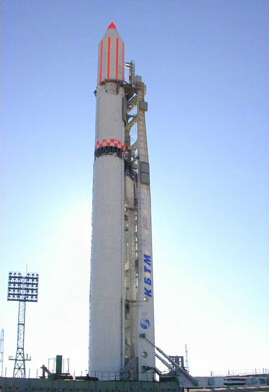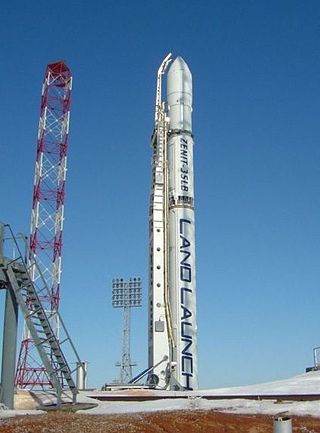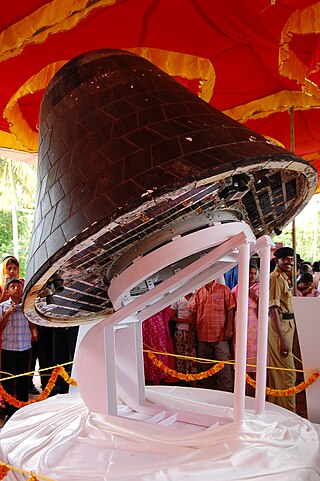
Plesetsk Cosmodrome is a Russian spaceport located in Mirny, Arkhangelsk Oblast, about 800 km north of Moscow and approximately 200 km south of Arkhangelsk, the cosmodrome dates to 1957. Originally developed as an ICBM site for the R-7 missile, it also served for numerous satellite launches using the R-7 and other rockets. Its high latitude makes it useful only for certain types of launches, especially the Molniya orbits, so for much of the site's history it functioned as a secondary location, with most orbital launches taking place from Baikonur, in the Kazakh SSR. With the end of the Soviet Union, Baikonur became a foreign territory, and Kazakhstan charged $115 million usage fees annually. Consequently, Plesetsk has seen considerably more activity since the 2000s.

Sea Launch was a multinational—Norway, Russia, Ukraine, United States—spacecraft launch company founded in 1995 that provided orbital launch services from 1999–2014. The company used a mobile maritime launch platform for equatorial launches of commercial payloads on specialized Zenit-3SL rockets from a former mobile/floating oil drilling rig renamed Odyssey.

Zenit is a family of space launch vehicles designed by the Yuzhnoye Design Bureau in Dnipro, Ukraine, which was then part of the Soviet Union. Zenit was originally built in the 1980s for two purposes: as a liquid rocket booster for the Energia rocket and, equipped with a second stage, as a stand-alone middle-weight launcher with a payload greater than the 7 tonnes of the Soyuz but smaller than the 20 tonnes payload of the Proton. The last rocket family developed in the USSR, the Zenit was intended as an eventual replacement for the dated Soyuz and Proton families, and it would employ propellants which were safer and less toxic than the Proton's nitrogen tetroxide/UDMH mix. Zenit was planned to take over crewed spaceship launches from Soyuz, but these plans were abandoned after the dissolution of the Soviet Union in 1991.

LP Odyssey is a self-propelled semi-submersible mobile spacecraft launch platform converted from a mobile drilling rig in 1997.
Thuraya is a United Arab Emirates-based regional mobile-satellite service (MSS) provider. The company operates two geosynchronous satellites and provides telecommunications coverage in more than 161 countries in Europe, the Middle East, North, Central and East Africa, Asia and Australia. Thuraya's L-band network delivers voice and data services.
Spaceway-3 is a communications satellite which was launched in August 2007. The third satellite in the Spaceway series, it includes a Ka-band communications payload. It is used by Hughes Network Systems to provide broadband Internet Protocol network service.
The Zenit-3SL is an expendable carrier rocket operated by Sea Launch. First flown in 1999, it has been launched 36 times, with three failures and one partial failure. It is a member of the Zenit family of rockets, and is built by the Yuzhnoye Design Bureau. RKK Energia produces the Block DM-SL upper stage, whilst the payload fairing is produced by Boeing. Launches are conducted from the Ocean Odyssey platform anchored on the equator in the Pacific Ocean, at a point with 154°W longitude, about 370 kilometres east of Kiritimati.
The Zenit-2M, Zenit-2SB, Zenit-2SLB or Zenit-2FG was a Ukrainian expendable carrier rocket derived from the Zenit-3SL. It was a member of the Zenit family of rockets, which were designed by the Yuzhmash.

Land Launch refers to a service product of Sea Launch SA. There is no entity or company called Land Launch. Sea Launch created the Land Launch offering to address lighter satellites directly into geosynchronous orbit or into geosynchronous transfer orbit, while Sea Launch continues to address the heavy satellite launch market.

The year 2007 contained several significant events in spaceflight, including a Chinese ASAT test, the launches of the US Phoenix and Dawn missions to study Mars and Asteroid belt respectively, Japan's Kaguya Lunar orbiter, and the first Chinese Lunar probe, Chang'e 1.

The Zenit-2 is a Ukrainian, previously Soviet, expendable carrier rocket. First flown in 1985, it has been launched 37 times, with 6 failures. It is a member of the Zenit family of rockets and was designed by the Yuzhmash.
MEASAT-3a is a communications satellite which MEASAT Satellite Systems intends to operate in geosynchronous orbit at 91.5 degrees East longitude. It was built by Orbital Sciences Corporation, based on the STAR-2 spacecraft platform.
The DirecTV satellite fleet is a group of communications satellites located at various geostationary orbits that DirecTV uses for their satellite television service and HughesNet internet service. The "DirecTV" prefix in their names has been changed to "T".

The Zenit 3SLB or Zenit-3M is a Ukrainian expendable carrier rocket derived from the Zenit-2SB. It is a member of the Zenit family of rockets, which were designed by the Yuzhnoye Design Office. Produced at Yuzhmash, the rocket is a modified version of the Zenit-3SL, designed to be launched from a conventional launch pad rather than the Sea Launch Ocean Odyssey platform. Most of components of the rocket are produced in Russia.

Elektro–L is a series of meteorological satellites developed for the Russian Federal Space Agency by NPO Lavochkin. The first satellite, Elektro-L No.1, was launched on 2 January 2011. It is the first Russian weather satellite that successfully operates in geostationary orbit, and is currently the second operational Russian weather satellite. The satellites have a mass of about 1620 kg and are designed to operate for 10 years each. They are capable of producing images of the Earth's whole hemisphere in both visible and infrared frequencies, providing data for climate change and ocean monitoring in addition to their primary weather forecasting role.
Eutelsat 70B is a commercial communications satellite run by Eutelsat. It was launched on 3 December 2012 and is designed to provide telecommunication services for the Middle East, Central Asia, South East Asia and parts of Africa. It will replace Eutelsat 70A, which was previously known as Eutelsat W5. That satellite, which was launched in 2002, currently occupies the same 70.5° E location this satellite is intended for.

Intelsat 27 was an American communications satellite which was to have been operated by Intelsat. Intended as a replacement for Intelsat 805, it was destroyed after the rocket carrying it to orbit fell into the Pacific Ocean 56 seconds after launch.
Intelsat 802 was a communications satellite operated by Intelsat. Launched in 1997 it was operated in geostationary orbit at a longitude of 174 degrees west for around fourteen years.
NSS-5 is a communications satellite operated by Intelsat and after by SES World Skies. Launched in 1997 it was operated in geostationary orbit at a longitude of 50.5 degrees east for around 14 years.
Intelsat 804 was a communications satellite operated by Intelsat. Launched in 1997 it was operated in geostationary orbit at a longitude of 44 degrees east for around 8 years.







